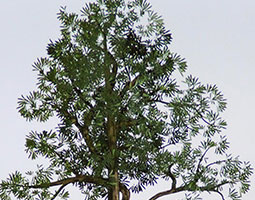Description

Glossopteris occurs in a variety of growth forms with the most common being the tongue-shaped leaf with prominent midrib and reticulate venation. Glossopteris leaves are ‘commonly found in thick mats causing some authorities to speculate that the plants were deciduous. Before the last of this group finally succumbed to extinction at the end of the Triassic Period it had become one of the major features of the flora of Gondwana. The distribution of this plant was among the first evidence for continental drift.
Glossopteris fossils provide important evidence for currently accepted distribution of continental plates in the Permian period that ended 250 million years ago. Fossils have been found in regions as distant as Patagonia, India and southern Australia. In the Permian, these landmasses were joined into a southern supercontinent known as Gondwana. The mass extinction that marks the end of the Permian period is believed to have led to the disappearance of Glossopteris.
Source: http://www.britannica.com/plant/Glossopteris